Abstract
The Worker Holiday Fund (WHF) was set up just after the Second World War as a state-dependent organization that arranged recreation for Polish workers under the socialist doctrine. The communist authorities turned organized recreation into a tool of indoctrination and propaganda. This research aims to characterize the seaside tourism architecture in the Polish People’s Republic (1949–1989) against the background of nationalized and organized tourism being used as a political tool, to typify the architecture and to verify the influence of politics on the development of holiday architecture in Poland. The research methodology is based on historical and interpretative studies (iconology, iconography and historiography) and field studies. The research helped distinguish four basic groups of holiday facilities: one form of adapted facilities (former villas and boarding houses) and three forms of new facilities (sanatorium-type, pavilion-type and lightweight temporary facilities, such as bungalows and cabins). The study found that each type of holiday facility was characterized by certain political significance and social impact. Gradual destruction was the fate of a significant part of WHF facilities, which, in the public awareness, are commonly associated with the past era of the Polish People’s Republic (PRL) as an “unwanted heritage”.
1. Introduction
The links between politics and architecture were and are undeniable [1,2,3,4], and inevitable in post-war Poland between 1949–1989. As Jałowiecki [5] (p. 46) points out, “of all the arts, architecture is the most strongly linked to ideology, and not only because it is often a tool of power, but also because buildings are preceded by words”. However, the influence of politics on architecture is not only revealed in individual projects that are monuments to power. The influence is much more fateful when there are attempts to change people’s social behavior [5] and shape new standards. There are many ways or methods to politicize architecture [6], and “the permanence of architecture makes it an excellent tool for ‘doing’ politics’” [4] (p. 30).
For many years, the former Eastern Bloc countries (in Europe: USSR, PPR, GDR, Czechoslovakia, Hungary, Romania, Bulgaria, Albania) have been pervaded by the socialist ideology, which left its mark on the social life of whole nations, revealing its form most clearly in the architectural doctrine of socialist realism. Socialist realism was the official artistic doctrine in force in the USSR since 1934 and from the late 1940s onwards in the other Eastern Bloc countries. In Poland, socialist realism triumphed between 1950 and 1955 according to the slogan: “(architecture should be) national in form and socialist in content”. Over the years, both the requirements of the imposed system and the realization of its ideological principles underwent a metamorphosis, reflecting the slow changes in the consciousness of the social group responsible for its increasingly unreliable image—architects. It was in their minds and on their drawing tables that a change in world-view was taking place, where the will of the authorities was seen as the only influence and guideline for design. The architecture was politicized and made subordinate to the authorities, and this view was accepted collectively by the architectural community at the Party-held National Meeting of Architects on 20 and 21 June 1949 in Warsaw. One of the leading doctrinaires of the new ideology, architect Edmund Goldzamt, said then: “an architect of a society, which builds socialism, is not only an engineer of edifices and streets but also an engineer of human souls. (...) in his works, in solid shapes, in the rhythms of openings, divisions, in the dynamics of forms, in the plasticity of surfaces, he must express the ideas of the present day—not the ‘ideas’ of a beautiful structure or sophisticated elegance of forms, but the social ideas in the name of which the human masses live and work” [7]. The time had begun when architecture became an image of socialist thought and a tool for shaping a new, socialist society. This is clearly emphasized by the following words uttered in 1948 by the then President of Poland, Bolesław Bierut: “Ideology finds in architecture an excellent way to embody itself. In what better way can we present our objectives, if not with panoramas and models of new cities” [8] (p. 9).
After many difficult years of compromises and distortions, many architects managed to shake off and set themselves on the path of a slow, creeping revolution, where their ambitions could be unleashed or channeled towards the delayed architecture of post-war modernism. The All-Poland Meeting of Architects in March 1956 openly condemned socialist realism. In search of symptoms of modernity, it was decided to discontinue the tradition of urban-planning layouts by destroying many of the spatial layouts of old cities, especially those in small towns [9,10]. The following years, or even decades, of apparent prosperity during the People’s Republic period offered illusory hopes for the creation of a “new society” that would be harnessed into yet another ideologized mechanism, subordinated to the implementation of centralized planning.
Against this background, from the early post-war years, the state authorities were developing new means of indoctrination addressed to the “modern workingman” and to the broad working masses by providing them with access to well-deserved recreation in their leisure time. These actions eventually created gratitude and reliance on an employer, a positive attitude to life, and thus the upbringing of a morally and physically strong man who could cope with life’s difficulties [11]. However, recreation was to be provided according to rules that ensured the authorities achieved one of their political goals, namely the indoctrination of society. The authorities wanted not only to tell people how to live, work and believe but also how to relax. It was no coincidence that a great ideological offensive was started at that time, as part of which it was decided to use holidays as a way of shaping the ‘correct’ world-view attitudes. It was only necessary to create an appropriate systemic tool. This tool was to be the Worker Holiday Fund and a form of centralized and organized recreation.
The Worker Holiday Fund (WHF) was set up just after the Second World War as a state-dependent organization that arranged recreation for Polish workers while the socialist doctrine was being applied. Holidays were a form of recreation organized for employees of state and society-owned work establishments and institutions in holiday resorts run by the WHF and located in attractive places throughout the country. State authorities utilized organized recreation as communist propaganda for indoctrination and to provide information about political successes. The architecture of the holiday resorts was designed to reflect the citizen equality policy and to align with the socialist concept of building a new post-war Poland.
Against this backdrop, this study aims to characterize seaside tourist architecture in the period of the People’s Republic of Poland (1949–1989) against the background of nationalized, organized mass tourism being used as a political tool. The aim is to typify the architecture on the basis of a structured database of WHF holiday facilities, and to verify the influence of politics on the development of holiday architecture in Poland.
The Worker Holiday Fund has been the subject of research by few authors who analyzed it in the context of tourism management and development [12,13] or leisure culture [11,14]. Research on the architecture of WHF facilities has not been conducted so far. In this context, this article is pioneering. The authors undertake a new thread of research: they characterize the buildings of the WHF in the context of architectural values and political conditions, trying to show the mutual relations between politics and architecture and the created form of recreation. This is the first study of this type, based on the collection of extensive iconographic material. The article is a consequence of the authors’ continuing research on tourist architecture in various historical periods. One of them is the difficult period of post-war architecture, strongly entangled in political and social aspects.
2. Materials and Methods
The research methodology is based on historical and interpretative studies and field studies.
Historical and interpretative studies in architecture, urbanism and landscape architecture have a long tradition. Their aim is primarily to describe, explain and interpret works of architecture. They indicate the relations between the studied objects and the context or historical background. This requires the use of archival materials, interviews, archaeological research and other sources of information. This type of research is characterized by a specific system of data collection. It consists of collecting data and source materials and keeping their records and assessing their value. Finally, the collected materials require interpretation [15]. According to Niezabitowska, “historical-interpretive research is practically the only strategy that presents an explanation of past events. They reveal the relationship between the studied facilities and the context or events of the past” [15] (p. 192). The adopted research procedure includes a set of actions commonly used in the historical-interpretive method and described by David Wang as: data collection and recording, identification of materials, organization of data collection, evaluation and analysis of collected materials, description and the end result—interpretation [16].
The analysis covered:
- identification of the indicated facilities, i.e., searching by the original address and location, reported to WHF as a holiday house, which consisted of many buildings scattered around the town. The identification was difficult because the given WHF holiday center’s facilities inventoried under one name (e.g., Błyskawica I) as a result of subsequent commercialization and privatization of the WHF property were usually rebuilt many times with their name changed. Finally, 58 holiday houses were identified (facilities are listed in Appendix A and Appendix B), including 38 in the Międzyzdroje district and 20 in the Koszalin district. Archival photos were found for most of them;
- spotting WHF holiday center’s facilities in the spatial structure of a town;
- comparing the past and present architecture of the facilities on the basis of the collected iconographic documentation (historical photos and postcards) with the materials obtained during field studies;
- analyzing, describing and interpreting, resulting in a typology of WHF holiday center’s facilities. The typology was based on the genesis of the object, architectural features and the influence of politics.
Interpretative and historical desk research included iconology and iconography, which can be used to interpret graphical representations (historical postcards, photographs, maps) and historiography, which deals with archival research (archive documents, journals, books). The source materials were obtained primarily from the Regional Office for the Preservation of Monuments, National Digital Archive, regional museums and private archives (mainly private collections of postcards and photographs), as well as websites with archival materials. The substantive scope and territorial coverage of the research were limited to the holiday facilities of the WHF located in the coastal belt of Western Pomerania (WHF districts of Międzyzdroje and Koszalin) (Figure 1 and Figure 2). The research did not take into account private accommodation, which was a marginal element of tourist development and was not related to the organized recreation services developed in the period considered.
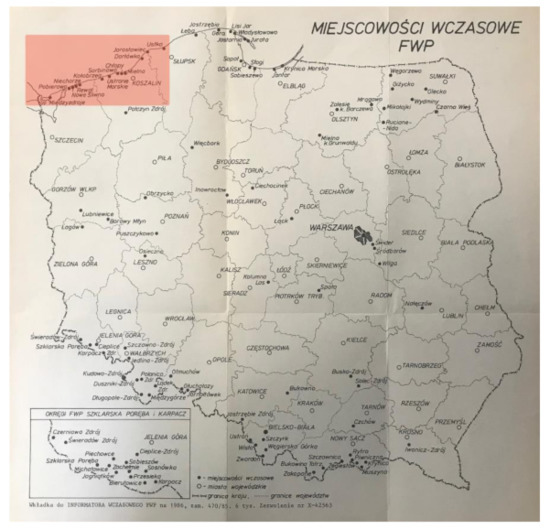
Figure 1.
Map from 1986 presenting location of towns where WHF had its facilities throughout Poland. The orange rectangle indicates the territorial scope of the study. Source: author’s work based on the archival map [17].

Figure 2.
Focusing on the territorial scope of the study. Seaside resorts on the coast in Western Pomerania included in the scope of the research (WHF districts of Międzyzdroje and Koszalin) are marked in red. As an example, a plan of Międzyzdroje with the location of WHF holiday facilities. Source: author’s work.
3. Development and Organization of Worker Holidays in the Polish People’s Republic
After the Second World War, Poland found itself in new political conditions and within new borders. The coastal belt was expanded to include the areas that had previously been within the borders of Germany (the province of Pomerania, East Prussia, the Free City of Gdańsk).
The post-war Polish authorities quickly noticed an important political tool in the development of recreation and tourism. The right to rest was guaranteed in article 59 of the Constitution of the People’s Republic of Poland of 22 July 1952, in chapter 7 on the fundamental rights and duties of citizens, where we can read, among other things, that the organization of holidays, development of tourism, health resorts, sports facilities, community centers in towns and villages, clubs, parks and other recreational establishments create opportunities for healthy and cultured rest for ever wider masses of working people in cities and rural areas [18]. Subsequent laws prolonging the duration of leaves (of absence) provided increasing opportunities for organized recreation [19,20]. However, apart from such an obvious goal, the organization of rest for citizens had a hidden purpose: propaganda and the indoctrination of society.
The concept of organized holiday recreation for working citizens adopted by the authorities was about changing the nature of rest and holiday destinations in order to shape a new society. The promotion of wide access to rest was intended to be an appreciation of the working masses and to facilitate the social integration of workers and intelligentsia. The opportunity to travel and relax, which had been available only to a few before the war, became a common good at that time. Apart from increasing the proportion of workers using holiday resorts, entertainment associated with the elite or bourgeoisie was to be eliminated. It was replaced with artistic events offered in holiday resorts, prepared according to a strictly controlled political–ideological scenario. These events fulfilled a campaigning–propagandist role and were to become commonplace.
Of particular political importance was the popularization of rest at the seaside, in areas acquired under the post-war border regulations, which had previously been part of Germany. Citizens resting by the Baltic Sea were supposed to manifest the Polishness of the coast and social equality [21]. As a result, rest, in the broadest sense of the word, transformed from an elite form into a mass one, widely available and even obligatory [22], and the previously elite resorts gradually transformed into resorts for the working masses [21].
Therefore, the development of social and mass tourism was a natural consequence of the adopted socialist political doctrine, while organized holiday rest was initiated by trade unions, whose activities strongly emphasized the provision of rest opportunities for workers. On 22 April 1945, the Executive Department of the Central Commission of the Trade Union Council set up the Department of Holidays [14,23]—the seed of a systemic tool of political indoctrination through recreation.
The organizational scattering between 1945 and 1948 and the disparities in the quality standards of service and management of the then modest holiday amenities necessitated the introduction of a stronger, centralized, statutory organization [24]. The central authorities had a simple purpose, namely one institution, subordinated to the Central Council of Trade Unions (CRZZ), was intended to take over almost all the holiday houses owned by trade unions and organize recreation for as many people as possible. The vast amounts of property owned mainly by the state and the trade unions were handed over entirely to the Worker Holiday Fund for management and use [25]. The creation of the WHF meant that, already, in the first decade of its holiday-related operation, between 1949 and 1958, it was the primary institution managing holidays [23], with exclusive rights to organize Worker Holidays for trade union members, subsidized from the state budget.
The WHF’s tasks were to organize, finance and coordinate Worker Holidays run by trade unions or directly by workplaces and run its own holiday houses [26].
In order to encourage workers to take holidays, a broad propaganda campaign was developed, mainly by works councils and the trade union press [11]. In order to achieve the planned indicators of the so-called “class proportions,” the holidaymakers were selected from blue-collar and white-collar workers to introduce some balance. In the Holiday Bulletin of 1947, one could read: “In a pleasant mood created by the possibility of spending time without concern about making a living in the future and without the feeling of compliance with the daily duties, the worker, the peasant and the intelligent, the young and the old, as well as enlightened citizens and illiterates do socialize” [27] (n.p). “There is no doubt that by getting to know our homeland better, everyone becomes a better, more loving citizen. Also, by living together, by having to comply with the rules applicable in these houses, through talks, excursions, concerts and other artistic and cultural events organized in these houses, the holidays contribute to the improvement of overall culture” [11] (p.21).
Over time, the objectives of the organization were formulated, significantly expanding socialist ideas to provide rest: “in the first instance to the leaders of work, rationalizers, innovators and masters of thriftiness, and to enable the renewal of the strength of workers employed in heavy and exhausting jobs. In organizing recreation, the task of the Worker Holiday Fund was also to conduct broadly conceived cultural and educational work in order to raise the class awareness of trade union members to a higher level. Through the international exchange of holidaymakers, the WHF should contribute to strengthening international contacts of the working class” [28]. In this way, the principles of social justice were put into practice [12], showing that the interests of the working circles were paramount for the WHF authorities [13]. From then on, rest and work understood as organized recreation (i.e., controlled and socially desirable) and the workplace were inextricably linked [29].
In 1945, 6500 accommodations located in resorts of varying standards were available for employee vacations and used by 12,663 people [30]. According to CSO data, in 1949, the WHF facilities already included 35,600 beds. The peak of the WHF’s dynamic development came in 1960; the Fund had at that time 36,000 beds, which were used by 431,700 people, which accounted for 89.4% of the holiday traffic in the country [14].
The material base of these operations consisted mainly of former private, social and state-run boarding houses abandoned (as a result of the war and related political system changes) or rented out by their owners. Some of the first works’ holiday centers at the seaside were opened in Jastrzębia Góra (1946), Międzywodzie (1947), Jastarnia, Kołobrzeg, Łeba and Międzyzdroje (1949). The preserved post-German health resort facilities from the so-called recovered territories were taken over by the State Treasury, and then handed over—under the Law of 4 February 1949 on the Worker Holiday Fund—to the Central Trade Union Committee in Poland for operation by the WHF to meet their growing needs [31]. In the WHF Statute of 02 September 1949, in § 36, which repeats the provisions of the Law of 4 February 1949, we can read that: “Assets owned by the State Treasury and state-owned enterprises may be transferred to the Fund, for administration and operation as needed, in a procedure provided for in applicable regulations, and in the absence of such regulations, by a resolution of the Council of Ministers. Real estate owned by the State Treasury and administered and operated by the Fund is accounted in the Fund’s assets as if it were its property” [26].
With such provisions, the holiday base was quickly expanded to include new facilities, and it developed by taking over and managing abandoned facilities, especially post-German ones, voluntarily transferring facilities (previously taken over by other institutions) to the WHF for administration while ensuring a certain share of holiday places for its own employees [32]. This included the progressive construction of new facilities. At the same time, guidebooks on the so-called Recovered Territories emphasized the preceding Germanization factor and the role of the Red Army in the liberation of the land, as well as the exceptional pace of land development during the Six-Year Plan period [11].
The construction of new facilities was directly linked to the establishment of the so-called social fund, under which work establishments were obliged to transfer part of the fund to build and run their holiday centers. By 1956, however, 75% of the buildings taken over for administration and operation were previously abandoned German estates located mainly in mountain and coastal areas, accounting for 91% of the total number of centers [11].
The basic structure of the Fund’s accommodation facilities, which were divided into four to twelve nationwide districts, consisted of holiday centers—a set of several vacation houses located in one town or spread across several relatively not-too-distant towns [26] (§ 26). In 1955, 77 works-linked holiday centers with almost 10,000 beds were registered throughout the country. They were located in 55 places, mainly in two regions: the northern coastal region and the southern mountain region [32].
WHF facilities were assigned to one of four grade categories. The categorization was based on the standard of amenities and construction and established by the management of WHF. The buildings in category I were those with the character of permanent buildings (regardless of material) equipped with central heating, hot and cold water, complete sanitary facilities (toilet, shower and washbasin) in each room and catering on site or in free-standing canteens. The buildings in category II were those with the character of permanent buildings (regardless of material) equipped with central heating, hot and cold water in rooms, common toilets and showers on each floor and catering on site or in free-standing canteens. Category III was assigned to buildings with a partly permanent nature (regardless of material) and partly of a camping nature, equipped with central heating, hot and cold water in the rooms, common sanitary facilities in the buildings and catering on site or in free-standing canteens. Category IV was for holiday houses and resorts that do not conform to the rules specified for the earlier categories [17].
An important event for the development of holidays was the extension of leave and the standardization of its duration for different groups of users. Under the 1969 Act on Employee Holidays, leave duration became identical for white-collar and blue-collar workers, and the maximum length of a continuous leave was one month. In addition, the monopolistic nature of WHF activities was abandoned in the late 1960s, and workplaces and trade unions were granted the right to build new holiday facilities. Since 1958, by the decision of the Fourth Trade Union Congress, each workplace was allowed to organize employee recreation [33,34].
Resolution No. 402 of the Council of Ministers of 10 December 1963 on non-operational social and living-related activities of state-run enterprises limited the WHF’s exclusive ownership and administration of holiday places and allowed for the construction of holiday centers. The staff of a workplace could finance the construction or adaptation of a holiday facility from its social fund, becoming its main user [32,35]. This significantly increased the number of people going on employee holidays and caused the concept of organized rest to develop further.
The years 1970–1977 are considered the peak of holiday construction, which resulted from a consistent policy of creating leisure conditions for working people [12,36], and are sometimes even referred to as the ‘decade of holiday construction’ [36] (p. 143).
However, the high financial subsidies from workplaces for their employees’ holidays, combined with a large number of holidaymakers, caused a crisis in this model of rest. The 1980s brought a marked decline in the quality of the existing facilities, the construction of new facilities ceased and the number of people taking holidays gradually decreased. This is confirmed by CSO statistics, which show that, in the early 1980s, there was a slump in the number of people taking holidays under the WHF. Eventually, with the transformation of the political system, the worker holiday system collapsed almost completely. The Act of 21 April 1988 on the Worker Holiday Fund transformed it into an organizational unit of the All-Poland Alliance of Trade Unions (OPZZ) [37], and the assets of the WHF (FWP) were transferred on 25 July 1997 to FWP Sp. z o.o., a company established by OPZZ. In a short time, the Constitutional Tribunal issued a ruling stating that the provisions used to take over the WHF’s assets, which should have belonged to the State Treasury, were unconstitutional [12].
4. Characterization and Typification of WHF Seaside Tourist Architecture in Western Pomerania
According to the data from the WHF reports for 1984, there were 27 holiday resorts on the Polish coast, including 13 in the region of Western Pomerania (the districts of Międzyzdroje and Koszalin), with 64 holiday centers (Table 1).

Table 1.
WHF resources on the Polish coast. Source: prepared by authors.
The seaside resorts in Western Pomerania where WHF holiday centers were located in the period of the PRL (Polish People’s Republic) included: Międzyzdroje, Pobierowo, Nowe Śliwno, Rewal, Niechorze, Kołobrzeg, Ustronie Morskie, Sarbinowo, Chłopy, Mielno, Darłówko, Jarosławiec, Ustka, Ustronie Morskie. The data contained in the FWP Brochures of 1978 and 1986 [17,23] indicate that each of the localities usually had several recreation centers (so-called holiday houses) consisting of several buildings of different categories (facilities are listed in Appendix A and Appendix B).
The vast majority of WHF holiday centers in Western Pomerania are examples of villa-style development from the turn of the 19th and 20th century or the beginning of the 20th century adapted to the needs of holidays (Figure 3a–d, Appendix C—Figure A1a,b). The buildings were post-German estates taken over by the State Treasury and then by the WHF. The architecture of the villas taken over by the WHF in its original, pre-war form was adapted to the elite character of seaside resorts and the mature phase of their development. The buildings were then decorated sumptuously. The most representative buildings from this period show influences of the Italian Renaissance and Neoclassicism. Some of the buildings are wooden buildings inspired by the so-called “Swiss-style” (a byword of summer resort wooden architecture). Most of the buildings of the so-called health resort architecture featured such elements as bay windows, finesse towers, large windows and verandas.
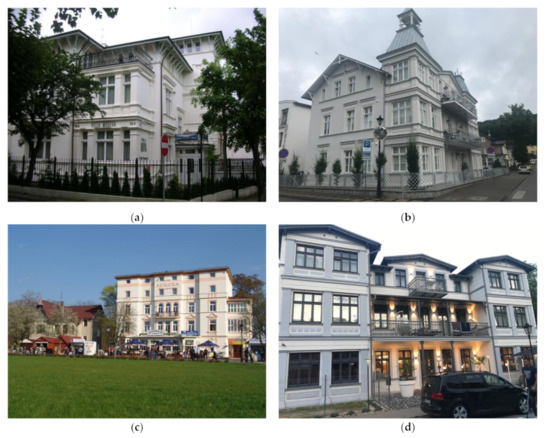
Figure 3.
Examples of villa-style development adapted to the needs of holidays in the area of Western Pomerania, in Międzyzdroje (a–d). Source: author’s work.
It is difficult to imagine that buildings in such an elegant setting could fully correspond to the proletarian assumptions of the WHF. In such facilities, it could have been a challenge to make the accommodation conditions equal for all guests and to provide an appropriately large canteen. The facilities, whose former function and villa character did not assume that a mass clientele would show up, were primitively adapted to the new functions of collective recreation by the then authorities.
It should be noted, however, that the taking over of the post-German property and the manifesting Polishness of the coast through the new seaside developments perfectly fulfilled the propaganda goals of the authorities.
Unfortunately, many of these pre-war villas and guesthouses were listed on the register of historic monuments too late. The lack of proper conservational and planning protection resulted in significant transformations in their form, function and usage. This was connected with the desire to adapt the buildings to the massive tourism. In particular, buildings located in valuable locations along seaside promenades (e.g., in Miedzyzdroje, Świnoujscie) were threatened with reconstruction or demolition. Their location and lack of protection often resulted in their total destruction and replacement with new high-rise developments, disturbing the waterfront line with their scale. Legally protected buildings that could not be demolished survived the hard times of overexploitation. In a few cases, after being commercialized and renovated by new owners, they regained their former glory and today recall the original character of the seaside resort in their form, scale and charm.
The following are typical examples of such buildings in Western Pomerania: DW Błyskawica, DW Fala, DW Minerwa, DW Aurora and DW Kasia located in Międzyzdroje.
There were far fewer new holiday centers built on the coast during the PRL period. However, three main groups of new facilities can be distinguished: large holiday facilities of the sanatorium type, pavilion-type facilities (up to 2 or 3 storeys) and light temporary buildings (various forms of camping houses).
New holiday facilities of the sanatorium type were often designed for large workplaces and then handed over to the administration of the WHF. The few constructed facilities of this group were complementary to the portfolio of the WHF, but their spatial and social importance, due to their scale and rank, was great for the town. The projects were designed to express the image of a new spirit in society and the country by introducing elements of modern (new) architecture, cutting itself off from the historical, pre-war buildings and the bourgeois past, consistent with the current socialist doctrine (Figure 4a–d, Appendix C—Figure A1c,d). This phenomenon was evident throughout the country, but, in the Recovered Territories, it was particularly glaring. The newly designed buildings were intended to provide equal accommodation conditions for all guests and to ensure that meals were eaten together, which was supposed to emphasize social equality. The typical features of the new architecture were cubicity, geometric shapes, repeatability of storeys, flat roofs and compactness of the form. The clear, post-war modernistic features were expressed by the reproduction of simple forms and structures, moving away from details, manifesting the health resort character by a large number of balconies and terraces stretching in rows along each storey. Often, in the vicinity of these buildings, there were located pavilions with additional functions, such as canteens, recreation rooms or treatment rooms. Due to their volume, the sanatorium-type leisure facilities often became dominant features in the landscape, but, unfortunately, they rarely fitted into the situational context. The modernist form was based on contrast to the cultural landscape, existing architecture and nature. Over time, some of the buildings became landmarks of the town, became its pride and, for the authorities of the time, proof of economic development, care of the state for the hardest working class and general prosperity. This is evidenced by numerous propaganda films, brochures and postcards from that period, showing mainly newly built holiday facilities by the sea.
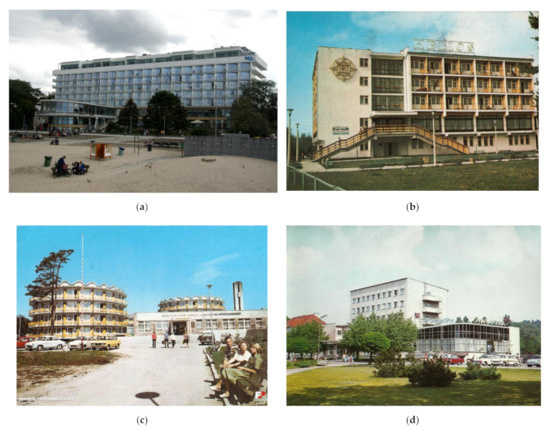
Figure 4.
Examples of new sanatorium-type facilities in the area of Western Pomerania: “Bałtyk” in Kołobrzeg (a), “Helios” in Dźwirzyno (b), “Włókniarz” in Dźwirzyno (c), “Posejdon” and “Piekiełko” cafe in Międzyzdroje (d). Source: author’s work (a), https://fotopolska.eu/ (accessed on 19 March 2021) (b–d).
Contrary to popular opinion about the poor quality of the facilities built at that time, in some of them, we can find examples of architecture characterized by an interesting shape, light structure, large glazing and dynamic form. The Bałtyk Health Sanatorium in Kołobrzeg, designed by Halina Gurianowa and Edmund Goldzamt in 1964 in the design firm run by Bohdan Pniewski, seems to deserve particular attention in this context. The building of the sanatorium of the Central Council of Trade Unions, situated on the seashore, is distinguished by its glazed façade facing the beach, with rows of diagonally arranged balconies adding variety and dynamism. “The lightness of the building is added by openwork elements crowning the roof terrace” [38] (p. 109). The modern glass façade allowed the visitors an unobstructed view of the sea directly from their rooms. In front of the main building, there was a two-storey glazed pavilion with rounded shapes, which housed a café and a canteen. The whole center was to be complemented with additional facilities: a cinema and theatre room and treatment and recreational area, which were never completed.
The examples of new sanatorium-type facilities in the area of Western Pomerania include: Bałtyk Health Sanatorium in Kołobrzeg, DW Posejdon in Międzyzdroje, DW Albatros in Mielno and DW Helios in Dźwirzyno.
Pavilion buildings (usually 2–3 storeys) were constructed more commonly, and examples can be found in every seaside resort of Western Pomerania (Figure 5a–h). Like the sanatorium-type facilities, pavilion-type buildings were to be characterized by a modern, geometric, simple shape, contrasting with the existing, sculptured, historic and “post-German” structures. Contextualization based on the clear contrast, inconsistent with the history of the buildings, was a manifestation of Polishness in the Recovered Territories. Unlike the historical villa buildings, the new pavilion structures were distinguished by the horizontal form of the shape and their cubicity. The effect was strengthened by an orderly rhythm of windows and loggias arranged alternately in strips, two to three storeys high, and a flat roof. Occasionally, stepped terraces or balconies were introduced to make the façade dynamic. Both the rows of balconies and a large amount of glazing were intended to provide the best possible view of the sea for all holidaymakers. The overall effect was simplicity and modernity, and the duplication of solutions resulted in an almost repetitive pattern. The principle of maximum functional simplification, uniform grade and formal expression adopted throughout the country was perfectly reflected in the solutions used in pavilion buildings. This corresponded with the adopted political doctrine and the propaganda of equality.
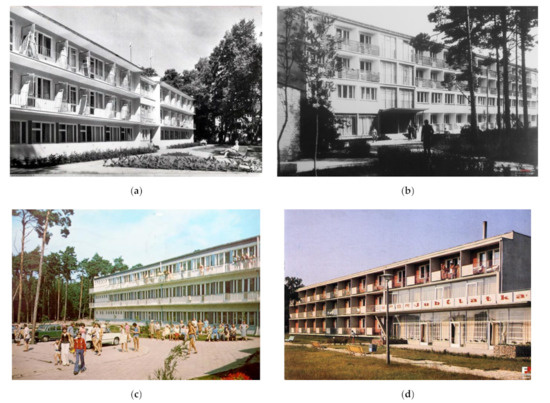
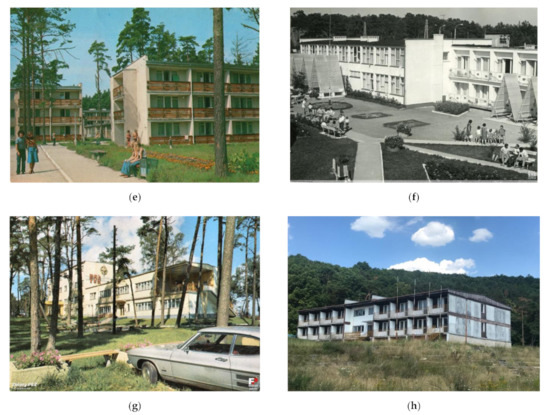
Figure 5.
Examples of pavilion buildings in seaside towns of Western Pomerania: “Jutrzenka” in Mielno (a), “Stoczniowiec” in Pogorzelica (b), holiday house in Dziwnówek (c), “Jubilatka” in Mrzeżyno (d), holiday house in Łukęcin (e), “Społem” holiday house in Dźwirzyno (f), “Bałtyk” in Dźwirzyno (g), holiday house in Wisełka (h). Source: https://fotopolska.eu/ (accessed on 20 April 2021) (a–g), author’s work (h).
At present, the pavilion buildings do not raise any conservationist sentiments as to their preservation or protection against adaptation or reconstruction. The necessity to adapt the buildings to actual norms and technical requirements as well as to raise the standard of hotel rooms has resulted in systematic transformations (elimination of common bathrooms, thermal modernizations, overbuilds, removal of social rooms and canteens). Although pavilion buildings are more durable than summer and camping houses or even pre-war guesthouses, they are exposed to stronger transformations and redevelopments that blur the modernist character of the standard “box” buildings of the communist period.
Representative examples of WHF pavilion buildings in the seaside towns of Western Pomerania include, among others: DW Dorwit and OSW Włókniarz in Dźwirzyno and DW Jutrzenka in Mielno.
Light temporary (seasonal) buildings in the PRL communist era were mainly complexes of cheap, seasonal structures consisting of small camping houses or holiday homes not permanently attached to the ground, made of light wooden construction and finished with a variety of cheap materials available in stores at that time, such as flax boards (Figure 6a–f, Appendix C—Figure A1e–g). Typically, such facilities had cuboid or pyramid shapes with a lean-to or gable roof covered with tar paper or asbestos cement sheet. One of the most popular models in the PRL times (since 1957) was the Brda type of cabin, whose gabled roof was the walls, and the front of the building formed a slender triangle. The tent-like shape made it possible to build a storey or a mezzanine inside, which, in practice, allowed for improvements to be made to the functional arrangement. As a standard, within a recreation complex, several or a dozen Brda-type cabins were erected, accompanied by one building and one canteen with a recreation room, an office and a kitchen. In the 1970s, Brda cabins also became available to individual customers.
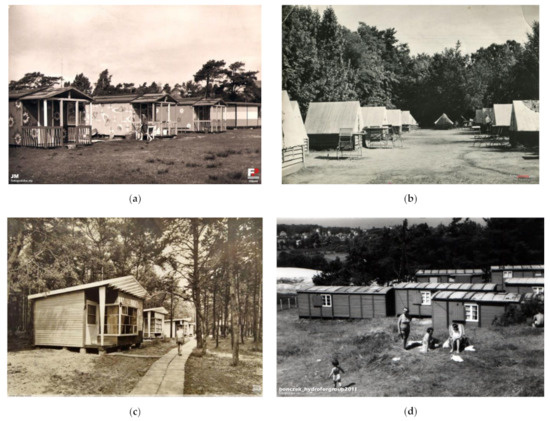

Figure 6.
Examples of light temporary (seasonal) buildings in: Dźwirzyno (a), Dziwnów (b), Jarosławiec (c), Międzyzdroje (d), Dziwnówek (e), Dziwnów (f). Source: https://fotopolska.eu/ (accessed on 20 April 2021) (a–e), author’s private collection (f).
This group included structures with more unusual and even avant-garde shapes. An example is the holiday house “Diogenes”, manufactured by construction works “Kombinat Budowlany Remo-Bud”. Diogenes was a kind of a caravan (because wheels could be installed under it for easy transport), with a distinctive shape resembling a barrel. It consisted of stylized segments, measuring 3.6 m at its widest point and 2.4 m high, produced in three different lengths: 3.4 m; 5.1 m; 6.8 m. As having an interesting form, Diogenes houses are certainly important for the characterization of this group of facilities, but they were rather intended for individual customers. In the coastal belt of Western Pomerania, no such complexes managed by the WHF were found during the research.
At present, the old summer and camping houses usually made of low-quality and non-durable materials are being replaced by new, modern buildings. A threat to light temporary building complexes is usually their attractive location in pine forests, in close proximity to dunes. They become a temptation for developers, who gather land for intensive, mass development.
One of the light temporary building complexes in Western Pomerania is the Trygław Recreation Centre of the Brda type in Międzyzdroje, which replaced the previously equally popular, later decommissioned wooden railway carriages. Railway centers with their rolling stock organized recreation in the initial period in complexes consisting of facilities withdrawn from use, such as railway carriages or kiosks, which typically provided a very low standard of recreation.
The typology proposed by the authors of this article takes into account: the genesis of the object, architectural features and the influence of politics. Each of the indicated types of holiday facilities were characterized by a certain political significance and social impact (Table 2). The propaganda and indoctrination of citizens were implemented by adapting former German villas and boarding houses to the needs of the FWP, changing the form, interior design and layout of new buildings in a way that enabled common recreation for the “working masses” and manifested the new social order. The development of temporary and seasonal housing, which was to ensure individualized and easy access to recreation, was also of political significance.

Table 2.
Typology of WHF holiday facilities on the coast in Western Pomerania and their political significance. Source: prepared by authors.
5. Discussion
Political ideologies have two specific goals: to arrange the social structure and to implement rules of behavior to achieve an ideal order in society [39,40]. To this end, authorities have used architecture in an undeniably political way for hundreds of years. Examples of ideologies that have significantly influenced architecture (e.g., Nazism, Marxism, Socialism and others) are numerous [41], while architectural and urban projects are often found in many countries [42,43,44,45].
Architecture is most obviously politicized by the manifestation of power through form. This can be done through the use of monumental scale, symmetrical composition, location or situational context [46,47]. In this context, architecture is a message and information [48] a kind of sign demonstrating power and authority, even inducing fear and humility. Due to its hidden symbolism, this message can have different meanings for different people with different social positions [49].
The arrangement of the space can also be used to express power, to emphasize authority and influence. As Lefebre notes, “architectural space does not simply mean to serve their own purposes, but is also part of the dominant discourse of power and domination in society” [50] (p. 99). In order to project power, space is arranged through spatial hierarchy, spatial structuring, spatial density and spatial division [51].
However, the possibilities of politicizing architecture are not always obvious. Architecture is also sometimes used by authorities to promote political ideologies and social indoctrination [52]. It then becomes an element of manipulation (more or less subtly) to promote patterns of behavior and social attitudes desired by the authorities.
In the case of the analyzed newly designed holiday facilities of the WHF, the formula of organized and collective recreation itself, the form of the facilities, the way of planning and functioning of the holiday homes and the standardization of space emphasizing the equality of citizens were of political significance. Holiday architecture could not be politicized and used for indoctrination and propaganda if it had not been subordinated to the work ethic of the PRL period.
Theorists of socialist ideology emphasize the importance of the social character of space. According to Lefebvre [50], space is a social product or complex social structure that influences spatial behaviors and perceptions. The produced space is a means of production, a means of control and thus of domination. Lefebvre [50] describes three dimensions of space, which are also the dimensions and areas of its production. These are: spatial practice, representations of space and representational space. In the context of the politicization of architecture, the space of representation connected with the sphere of symbols, cultural codes and ideas about space seems to be particularly important because, as Thrift [53] points out, in order to be an important element of ruling power, space must be symbolically presented and territorially delimited. Lefebvre attributed a key role in the politicization of space to architects, whom he saw as demiurges who established and dogmatized a whole set of meanings by assigning labels to them: function, form, structure. Moreover, according to him, architects’ lack of affiliation with an institution makes them tend to shut down, impose and nullify any criticism [54]. However, this does not seem to be adequate to the situation in Poland. It should be noted that Lefebvre’s views were based on his observations of social life in France, conditions that were diametrically opposed to those in the socialist countries, where projects were created in centralized and politicized (party-politicized) large design offices.
During the PRL period, political decisions were the primary factor determining the social making of space, which, in the case of rest, was subordinated to production [55]. There was a process of the appropriation of recreational space by large industrial enterprises and other institutions. To improve the conditions for the reproduction of the labor, recreational areas were appropriated and spatial forms of rest were produced in accordance with the maximization of individual interests and the differentiation of recreational standards between different categories of workers. As a result, in many regions, the landscape and natural environment were devastated, and resources valuable for the development of tourism and recreation were degraded [55]. On the other hand, according to Cymer, “the architecture of the PRL remained very strongly linked to the political history of the People’s Republic of Poland and was often even dependent on it. We often talk about the nationalization of the architecture in the PRL, about the tyranny of large design firms, about the enslavement of artists by the poor quality of materials produced by the economy of the People’s Republic of Poland. (...) they were allowed to suffer far-reaching neglect and often even devastation. Buildings aged in an ugly manner, not because of poor quality of design, but the quality of materials and the negligence of later owners and users” [56].
Currently, developments from the PRL period are often referred to as dissonant heritage—a term used to describe material evidence of the tragedies of genocide or colonialism, as well as totalitarian regimes [2,29,57]. Because “the WHF employee holidays have permanently become the customs of working people in Poland as a real achievement of the socialist system” [58] (p. 48), some scholars consider that the architecture of holiday centers erected during the PRL period meets the criteria of ‘dissonant’ and ‘undesirable’ heritage [29]. Therefore, the architecture of WHF centers is often criticized and depreciated nowadays, regardless of its actual value, aesthetic or functional qualities. Negative values of the holiday architecture of the PRL period are also noted in its impact on the landscape, which was associated with the construction of large buildings in the 1960s and 1970s in the most attractive tourist destinations [59]. Numerous buildings with very large sizes and sometimes not very diverse shapes permanently changed the scale of traditional assumptions and their relationship with the natural landscape [60] (p. 35). However, it cannot be ignored that some of the holiday facilities newly built in the PRL period were distinguished by their good scale, light form and resemblance to the old, traditional buildings of the seaside resorts more than many facilities built on the coast in recent years [61]. However, there is no doubt that the architecture of the PRL-era resorts was an element of the state’s modernization policy [29] and a tool of manifestation and indoctrination, more and less valuable examples of which we find in this study.
It should also be noted that the phenomenon of the politicization of architecture is not disappearing. One of its contemporary manifestations is where ‘starchitects’ design to order. Starchitects effectively sell their name to totalitarian regimes and, by designing for them, they actually serve them directly. In exchange for the possibility of full freedom in completing projects and the ability to build without restrictions (legal, economic), starchitects contribute to the strengthening of authoritarian power [62].
6. Conclusions
The review and analysis of the WHF holiday architecture from the PRL period located in the seaside towns of Western Pomerania allowed four main groups of facilities to be distinguished:
- adapted facilities: former villas and guesthouses
- new facilities: sanatoriums
- new facilities: pavilions
- new facilities: light, temporary (summer and camping houses).
It was also possible to characterize these groups and verify the relationship between architecture and politics.
Throughout the whole analyzed period, the WHF operated the post-German resort architecture found on the coast, including wooden half-timbered architecture covered with lining boards that was later replaced by brick and stone buildings (also historically stylized), still supplemented with elements of wooden balconies, loggias or towers. Single-family villas were converted into multi-person holiday centers, where rooms accommodated more and more visitors, and boiler rooms, sanitary facilities or shared toilets were added. All-day meals were provided in an additional common room, and catering pavilions or canteens (seasonal and year-round) served several local centers in shifts. Both the adaptation of former German facilities to the needs of the WHF and the functional changes had a strong political background, namely the manifestation of Polishness in the so-called “recovered territories” and of the new political system.
In the era of PRL’s standardization and industrialization of construction, it was not easy to be individualistic and original. Individual architectural activity disappeared, and the design industry was monopolized by design consultants. New construction primarily had to be modern and accessible. The new holiday facilities built during the PRL period were usually cubic, free-standing shapes whose determinants were modesty, cost effectiveness, functionality and, unfortunately, often being built in an unceremonious location.
Since the provisions and postulates were selectively derived from the Athens Charter, the principles of the so-called new urbanism and planning that exploited the cultural continuity and tradition of the place were introduced. The strongly scattered buildings did not create clear references to the existing cultural context that was generally in contrast with the existing buildings. “Cult” oeuvres were rarely created, but we do find in the realizations of that period some that became local landmark features. Only a few of them, now renovated, pay tribute to the “rightly bygone” times and the PRL culture of recreation.
Unfortunately, gradual destruction was the fate of a significant part of the WHF facilities, which, in public awareness, are commonly associated with the past era of the Polish People’s Republic (PRL) as an “unwanted heritage”. Often, the standard and typified holiday buildings quickly became obsolete due to their boring repetitiveness as well as poor-quality construction materials, the pace of piecework and poor workmanship. The “powdering” of the façades and the brief, routine renovations did not protect the structures of the buildings, which were strained by time and excessive wear, often leading to their depreciation. This applies both to former German villas and to boarding houses, which were taken over after the war by WHF, and to new buildings built in the PRL period.
The holiday architecture in the People’s Republic of Poland was undoubtedly strongly connected with politics and its influence on the way of rest that was comprehensively programmed. It was presented as a great achievement of the authorities of the time and a sign of their concern for citizens and working people. It must not be forgotten, however, that architecture pursued important social objectives, contributing to the mass popularization of rest and recreation.
Today’s attempts at the modernization and adaptation of former WHF facilities are a serious challenge, especially to the current landlords, who usually find the buildings to be of low aesthetic value, ordinary and of low standard. They tend to introduce far-reaching changes through extensions and new superstructures, introducing energy retrofitting or painting bizarre colors. As a result, the shapes and proportions of the buildings and, eventually, their perceptions, are changed, the latter discontinuing their original character.
It would be desirable to initiate protective actions related to the establishment of cultural parks compounded of several curative autonomous areas and conducting comprehensive research in order to select landscape units (enclaves) with the revitalization potential. The only way to protect buildings from deconstruction and intensive development may be a conscious planning (including protection against urban sprawl as an uncontrolled process of the absorption of land for new construction and efforts to protect the national heritage), which will prevent the areas from overdevelopment, their intensification, and the localities in the coastal belt from their excessive growth and merging.
All the contemporary humanities are interested in the PRL period: in film, literature, art and, finally, architecture, which, today, could be a testimony to a bygone era. However, achieving this would require an understanding of the sources and conditions of the architecture in which it was created in order to be able to accept it more readily and properly highlight its qualities.
Author Contributions
Conceptualization, W.B. and M.C.-P.; Methodology, W.B. and M.C.-P.; Formal Analysis, W.B. and M.C.-P.; Investigation, W.B. and M.C.-P.; Resources, W.B. and M.C.-P.; Writing—Original Draft Preparation, W.B. and M.C.-P.; Writing—Review & Editing, W.B. and M.C.-P.; All authors have read and agreed to the published version of the manuscript.
Funding
This research received no external funding.
Institutional Review Board Statement
Not applicable.
Informed Consent Statement
Not applicable.
Data Availability Statement
The data presented in this study are available in Appendix A and Appendix B.
Conflicts of Interest
The authors declare no conflict of interest.
Appendix A

Table A1.
WHF’s holiday houses in Międzyzdroje district.
Table A1.
WHF’s holiday houses in Międzyzdroje district.
| Międzyzdroje District | |||
|---|---|---|---|
| Locality | Number | Holiday House | Archive Photo/Address |
| Międzyzdroje (76 buildings, 36 camping houses) | 1 | “Błyskawica” holiday house made up of 7 buildings:
| 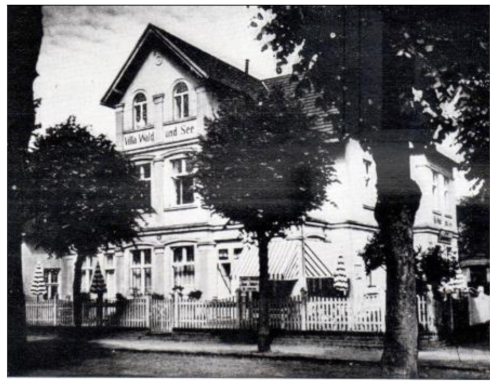 “Błyskawica” WHF’s holiday house. Pre-war photo. https://fotopolska.eu/ (accessed on 7 June 2021) Address: Książąt Pomorskich Street, no.17 |
| 2 | “Delfin” holiday house made up of 5 buildings:
| 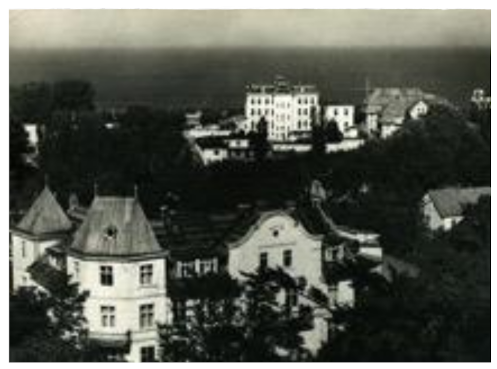 The view from the church tower in Międzyzdroje. In the foreground, “Delfin” holiday house, between 1960 and 1965. https://fotopolska.eu/ (accessed on 7 June 2021) Address: Zwycięzców Street, no. 13 | |
| 3 | “Energia” holiday house made up of 5 buildings:
| 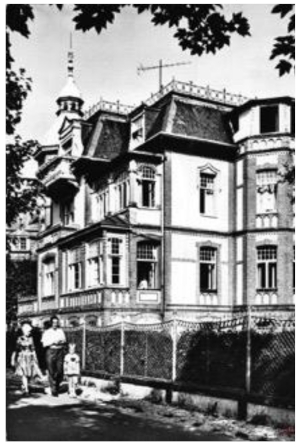 “Energia III” WHF’s holiday house, 1965. https://fotopolska.eu/(accessed on 7 June 2021) Address: M. Fornalskiej Street, no. 3 (present: Plażowa Street) | |
| 4 | “Fala” holiday house made up of 4 buildings:
| 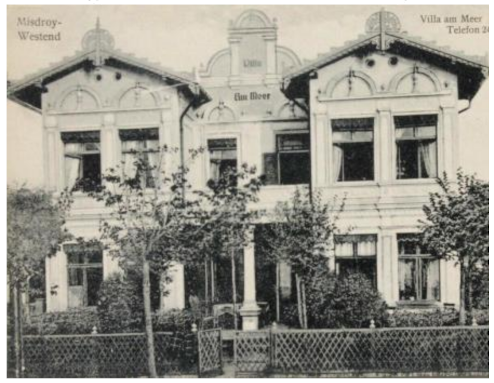 “Fala” WHF’s holiday house. Pre-war photo. https://fotopolska.eu/ (accessed on 19 March 2021) Address: Bohaterów Warszawy Street, no. 8 | |
| 5 | “Kasia” holiday house made up of 11 buildings:
|  “Kasia” Holiday House. Wczasy Pracownicze FWP. Informator FWP. 1978. Warszawa: Instytut Wydawniczy CRZZ, p. 175. Address: Ludowa Street, no. 1 | |
| 6 | “Korsarz” holiday house made up of 4 buildings:
| 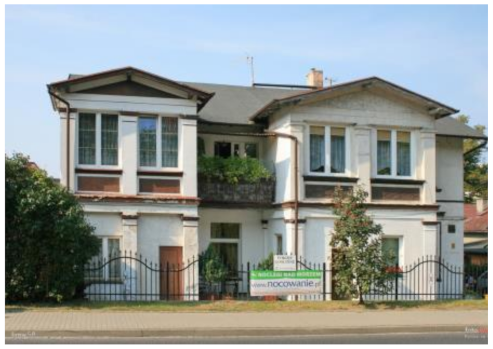 “Korsarz” WHF’s holiday house. https://fotopolska.eu/ (accessed on 19 March 2021) Address: Zwycięstwa Street, no. 33 | |
| 7 | “Latarnia Morska” holiday house made up of 5 buildings:
| 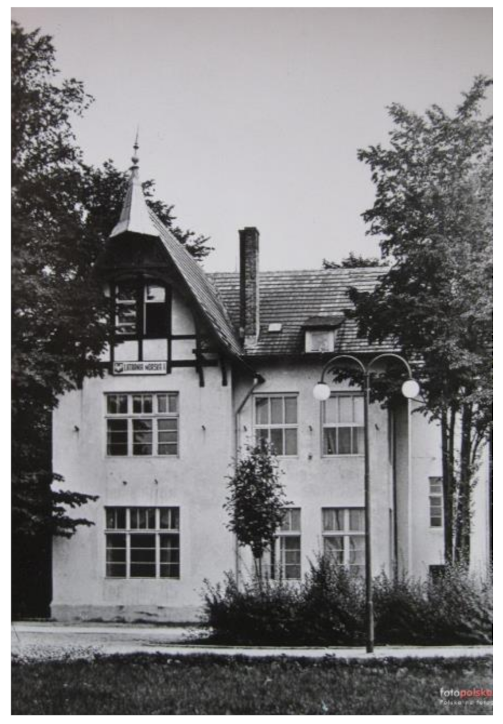 “Latarnia Morska” WHF’s holiday house. Pre-war photo. https://fotopolska.eu/ (accessed on 19 March 2021) Address: Bohaterów Warszawy Street, no. 18 | |
| 8 | “Leśnik” holiday house made up of 36 camping houses:
| No archival photos available Address: Leśna Street, no. 15 | |
| 9 | “Mars” holiday house made up of 3 buildings:
| 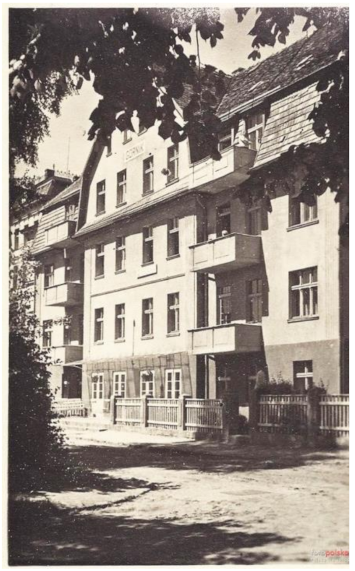 “Mars” WHF’s holiday house. Pre-war photo. https://fotopolska.eu/ (accessed on 19 March 2021) Address: 1000-lecia Państwa Polskiego, no. 3 | |
| 10 | “Mewa” holiday house made up of 4 buildings:
| No archival photos available Address: Pomorska Street, no. 9 | |
| 11 | “Minerwa” holiday house made up of 5 buildings:
| 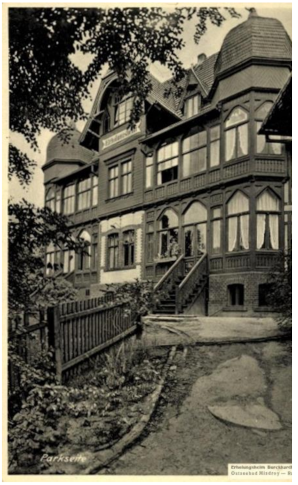 “Minerwa” WHF’s holiday house. Pre-war photo. https://fotopolska.eu/ (accessed on 7 July 2021) Address: Zdrojowa Street, no. 10 | |
| 12 | “Morskie Oko” holiday house made up of 4 buildings:
| No archival photos available Address: Lipowa Street, no. 3 | |
| 13 | “Patria” holiday house made up of 5 buildings:
| No archival photos available Address: Rybacka Street, no. 1 | |
| 14 | “Polonia” holiday house made up of 1 building:
| 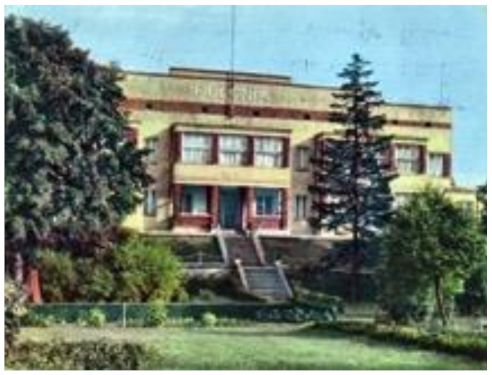 Międzyzdroje. “Polonia” WHF’s Holiday House, between 1965 and 1968. Photo J. Korpal. Postcard by RUCH. https://fotopolska.eu/ (accessed on 5 July 2021) Address: Bohaterów Warszawy Street, no. 30 | |
| 15 | “Posejdon” holiday house made up of 1 building:
| 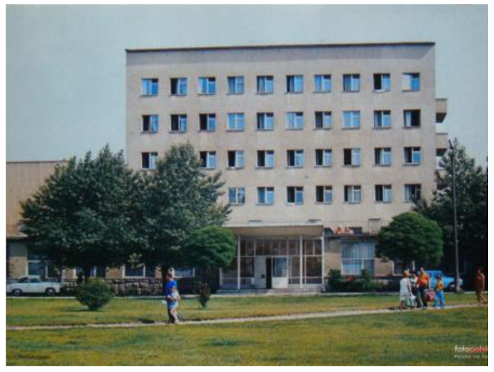 “Posejdon” holiday house, between 1970 and 1972. https://fotopolska.eu/ (accessed on 19 March 2021) Address: Bohaterów Warszawy Street, no. 23 | |
| 16 | “Rybitwa” holiday house made up of 4 buildings:
| 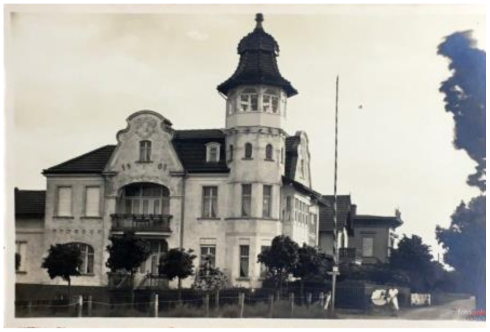 “Rybitwa” holiday house, between 1934 and 1939. https://fotopolska.eu/ (accessed on 7 July 2021) Address: Bohaterów Warszawy Street, no. 4 | |
| 17 | “Sorrento” holiday house made up of 5 buildings:
| 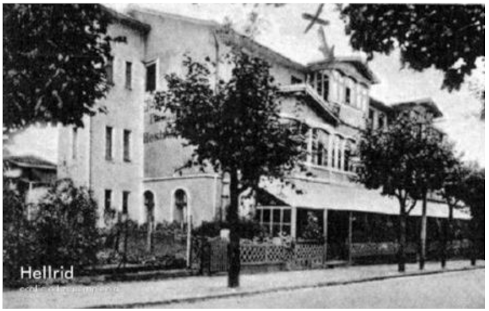 “Sorrento” holiday house. https://fotopolska.eu/ (accessed on 7 July 2021) Address: Traugutta Street, no. 1 | |
| 18 | “Warszawianka” holiday house made up of 4 buildings:
| No archival photos available Address: Ludowa Street, no. 9 | |
| Niechorze (49 buildings) | 1 | “Błękitna” holiday house made up of 7 buildings:
| No archival photos available Address: East Street, no. 4 |
| 2 | “Liwia” holiday house made up of 2 buildings /administered by WHF/
| No archival photos available Address: Marchlewskiego Street, no. 16 (present: Amber Avenue) | |
| 3 | “Niechorzanka” holiday house made up of 2 buildings:
| 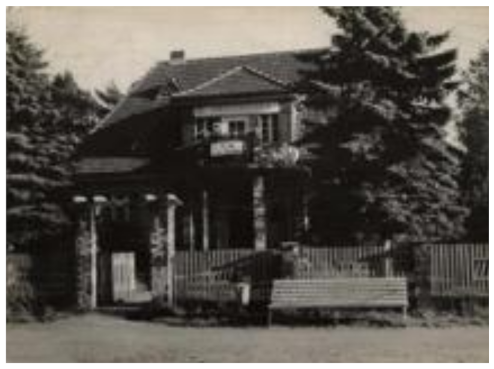 “Niechorzanka” holiday house, currently the Museum of Maritime Fishery in Niechorze, between 1960 and 1970. https://fotopolska.eu/ (accessed on 3 May 2021) Address: Wolska Street, no. 8 | |
| 4 | “Rybak” holiday house made up of 6 buildings:
| No archival photos available Address: Morska Street, no. 8 | |
| 5 | “Syrena” holiday house made up of 11 buildings:
| No archival photos available Address: Szczecińska Street, no. 4 | |
| 6 | “Zacisze” holiday house made up of 10 buildings:
| 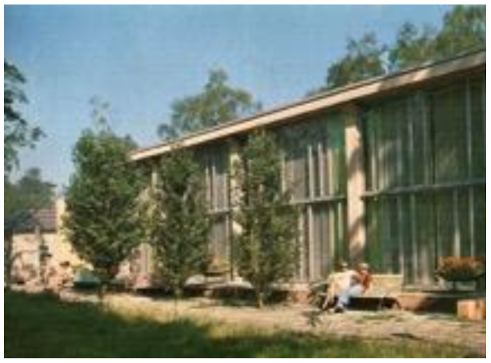 The dining room of the “Zacisze” WHF’s Holiday House, between 1967 and 1977. Postcard by KAW. https://fotopolska.eu/ (accessed on 12 July 2021) Address: Marchlewskiego Street, no. 20 (present: Amber Avenue) | |
| 7 | “Zielona” holiday house made up of 12 buildings:
|  “Zielona” holiday house—Mewa, 1939. https://fotopolska.eu/ (accessed on 8 July 2021) Address: Krakowska Street, no. 3 | |
| Nowe Śliwno (8 buildings) | 1 | “Oaza” holiday house made up of 8 buildings:
| No archival photos available Address: Nowe Śliwno |
| Pobierowo (337 summer houses,71 camping houses,2 pavilions) | 1 | “Bałtyk” holiday house made up of 34 houses:
|  “Bałtyk” WHF’s Holiday House, between 1976 and 1977. Photo J. Tymiński. Postcard by KAW. https://fotopolska.eu/ (accessed on 3 May 2021) Address: Grunwaldzka Street, no. 25 |
| 2 | “Barbórka” holiday house made up of 57 houses:
| 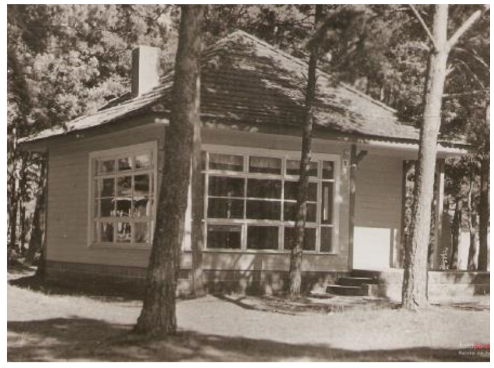 Pobierowo. One of the summer houses. https://fotopolska.eu/ (accessed on 8 July 2021) Address: Grunwaldzka Street, no. 7 | |
| 3 | “Bursztyn” holiday house made up of 56 houses:
| No archival photos available Address: Gdańska Street, no. 5 | |
| 4 | “Meduza” holiday house made up of 59 buildings:
| 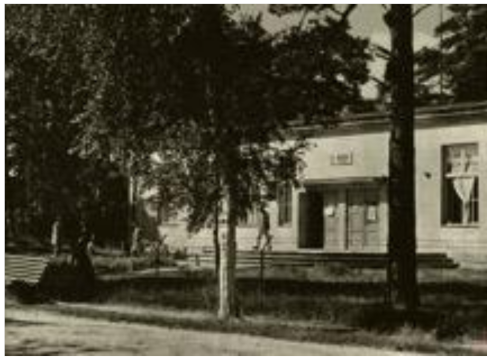 FWP Meduza. RSW Ruch, 1969. Photo W. Wojtkiewicz. https://fotopolska.eu/ (accessed on 3 May 2021) Address: Grunwaldzka Street, no. 51 | |
| 5 | “Muszla” holiday house made up of 60 buildings:
| 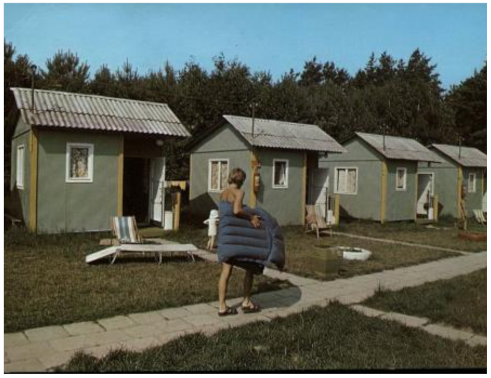 Camping houses, between 1975–1980. https://fotopolska.eu/ (accessed on 8 July 2021) Address: Piastowska Street, no. 29 | |
| 6 | “Słoneczna” holiday house made up of 47 houses:
| 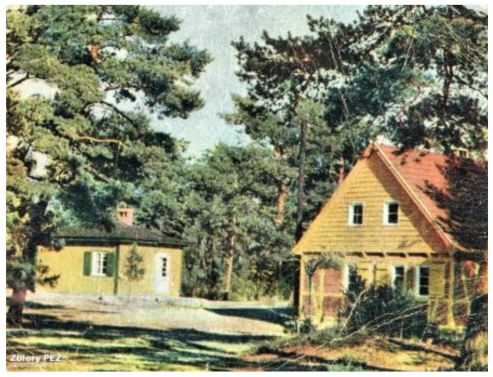 Summer houses, between 1959–1960. Photo E. Czapliński i A. Stelmach. Postcard by RUCH. https://fotopolska.eu/ (accessed on 8 July 2021) Address: Pomorska Street, no. 1 | |
| 7 | “Wisła” holiday house made up of 24 houses:
| Address: Grunwaldzka Street, no. 4 | |
| Rewal (31 buildings, 10 pavilions) | 1 | “Gwiazda” holiday house made up of 5 buildings:
| 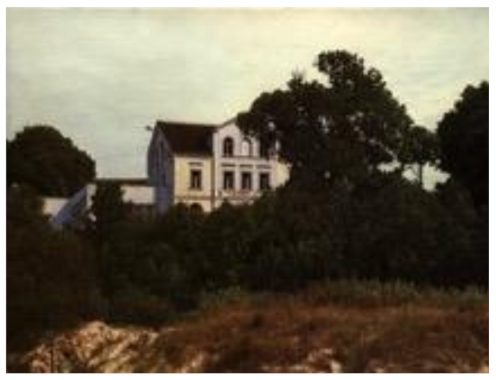 “Zdrój” holiday house in Rewal.Photo J. Tymiński. Postcard by KAW, 1970–1975. https://fotopolska.eu/ (accessed on 7 June 2021) Address: Saperska Street, no. 6 |
| 2 | “Idylla” holiday house made up of 5 buildings:
| 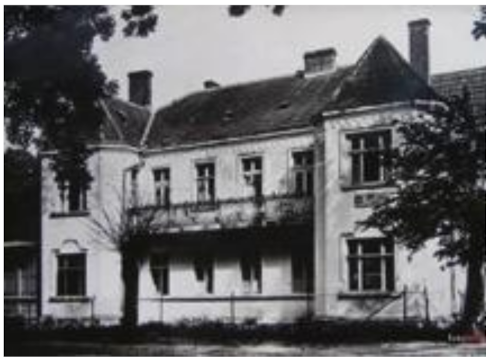 “Idylla” Holiday House in Rewal, 1960–1970. https://fotopolska.eu/ (accessed on 7 June 2021) Address: Saperska Street, no. 13 | |
| 3 | “Maryla” holiday house made up of 6 buildings:
| 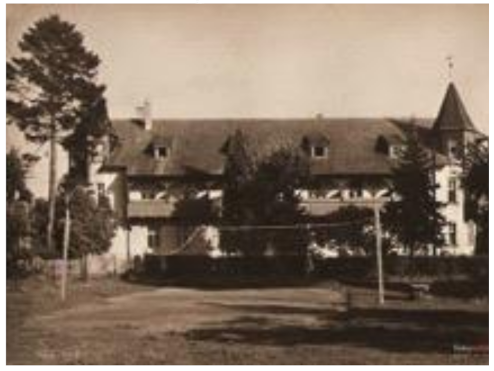 “Maryla” holiday house in Rewal, 1960–1965. https://fotopolska.eu/ (accessed on 3 May 2021) Address: Mickiewicza Street, no. 1 | |
| 4 | “Radość” holiday house made up of 10 buildings:
| 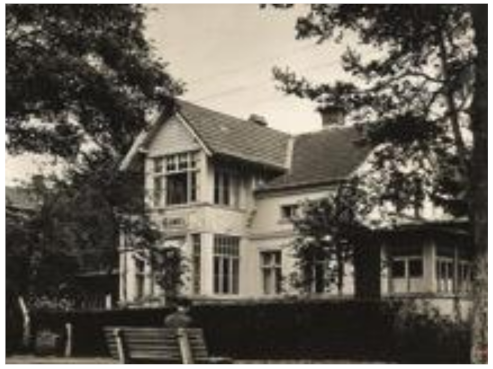 “Radość” Holiday House, 1959–1961. Postcard by Publ. House of Trade-unions CRZZ. Photo M. Holzman. https://fotopolska.eu/ (accessed on 3 May 2021) Address: Westerplatte Defenders Street, no. 12 | |
| 5 | “Strażnica” holiday house made up of 4 buildings:
| No archival photos available Address: Mickiewicza Street | |
Appendix B

Table A2.
WHF’s holiday houses in Koszalin district.
Table A2.
WHF’s holiday houses in Koszalin district.
| Koszalin District | |||
|---|---|---|---|
| Locality | Number | Holiday House | Archive Photo/Address |
| Chłopy (4 buildings) | 1 | “Odra” holiday house made up of 4 buildings:
| 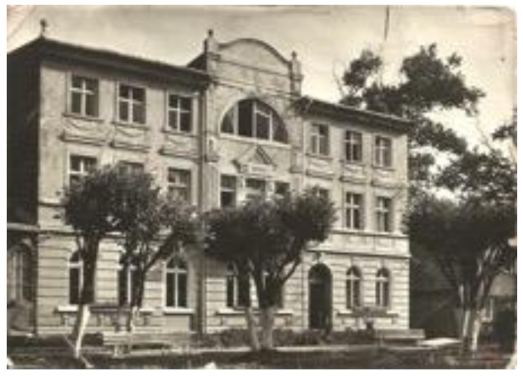 The former “Strandschloss” hotel, later “Odra” holiday house. Postcard by Ruch Publishing Office. Between 1960 and 1965, https://fotopolska.eu/ (accessed on 3 May 2021) Address: Sarbinowo, no. 96 |
| Darłówek (7 buildings) | 1 | “Antena” holiday house made up of 7 buildings:
| 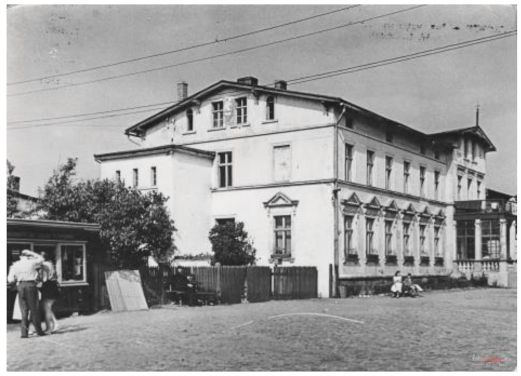 “Antena” holiday house. https://fotopolska.eu/ (accessed on 11 June 2021) Address: Kąpielowa Street, no. 11 |
| Jarosławiec (213 summer houses) | 1 | The “Baltic” holiday house made up of summer houses.
| 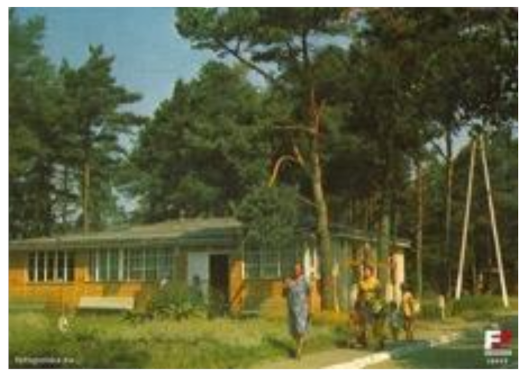 WHF’s “Bałtyk” centre in Jarosławiec. Between 1970 and 1980. https://fotopolska.eu/(accessed on 3 May 2021) Address: n/a |
| Kołobrzeg (2 buildings) | 1 | “Bałtyk” Sanatorium and Recreation Centre for Trade Unions, made up of 2 buildings:
| 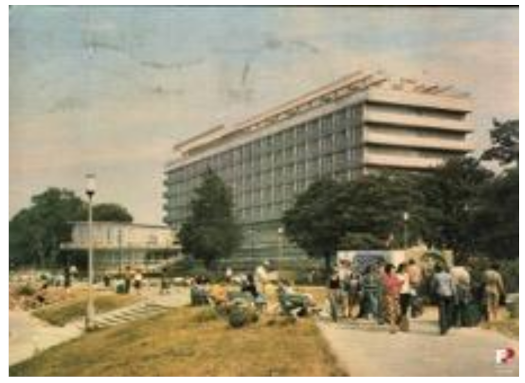 “Bałtyk” Sanatorium and Recreation Centre, 1976. Photo T. Zagoździński. Postcard by KAW. https://fotopolska.eu/ (accessed on 3 May 2021) Address: Rodziewiczówny Street, no. 1 |
| Mielno (29 buildings) | 1 | “Bandera” holiday house made up of 9 buildings:
| 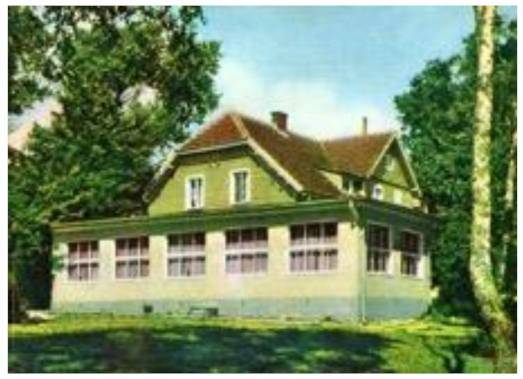 “Bandera 7” WHF’s Holiday House, Between 1962 and 1964. Postcard by RUCH. https://fotopolska.eu/ (accessed on 5 June 2021) Address: Pionierów Street, no. 16 (building doesn’t exist) |
| 2 | “Dar Pomorza” holiday house made up of 6 buildings:
| 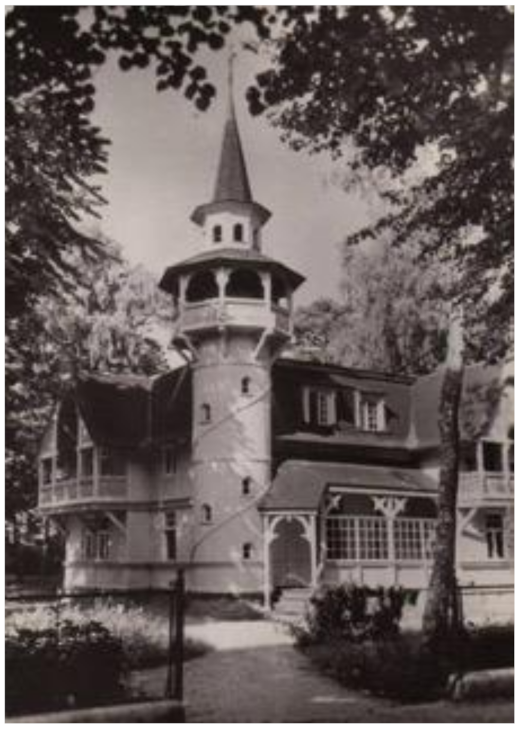 “Dar Pomorza” holiday house in Mielno, between 1950 and 1960, https://fotopolska.eu/ (accessed on 5 June 2021) Address: 1 Maja Street, no. 10 (building doesn’t exist) | |
| 3 | “Jantar” holiday house made up of 3 buildings:
| 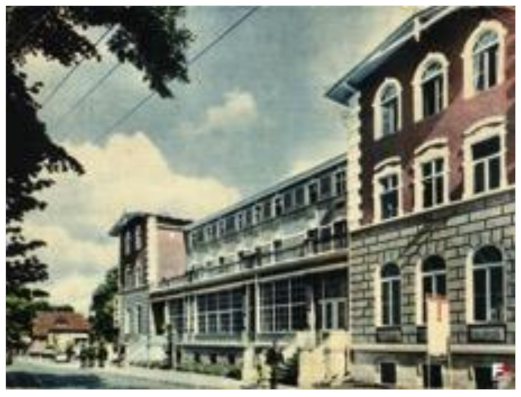 “Jantar I” WHF’s Holiday House, between 1958 and 1960. Postcard by RUCH. https://fotopolska.eu/ (accessed on 5 June 2021) Address: B. Chrobrego Street, no. 4 (building does not exist) | |
| 4 | “Perła” holiday house made up of 8 buildings:
| No archival photos available Address: B. Chrobrego Street, no. 43 | |
| 5 | “Jutrzenka” holiday house made up of 3 buildings:
| 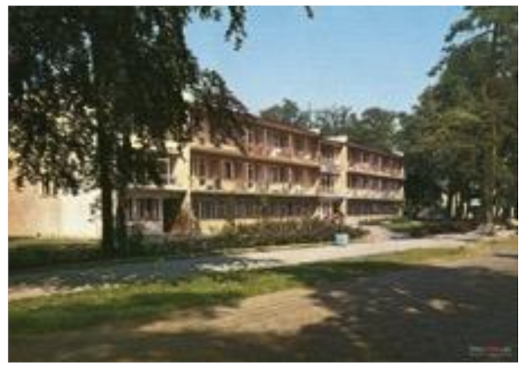 “Jutrzenka” WHF’s Holiday House, between 1974 and 1976. Postcard by KAW. https://fotopolska.eu/ (accessed on 5 June 2021) “Jutrzenka” WHF’s Holiday House, between 1974 and 1976. Postcard by KAW. https://fotopolska.eu/ (accessed on 5 June 2021)Address: Nadbrzeżna Street, no. 2 | |
| Sarbinowo (13 buildings) | 1 | “Mewa” holiday house made up of 6 buildings:
| 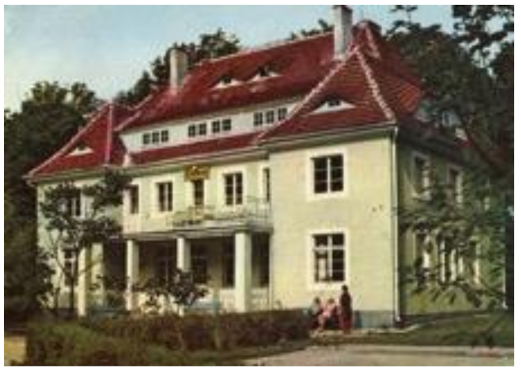 “Mewa II” WHF’s Holiday House, between 1962 and 1964, Postcard by RUCH. https://fotopolska.eu/ (accessed on 3 May 2021) Address: n/a |
| 2 | “Ślązaczka” holiday house made up of 7 buildings:
| No archival photos available Address: n/a | |
| Ustka (9 buildings, 24 pavilions, 61 summer houses) | 2 | “Czarodziejka” holiday house made up of 5 buildings:
| 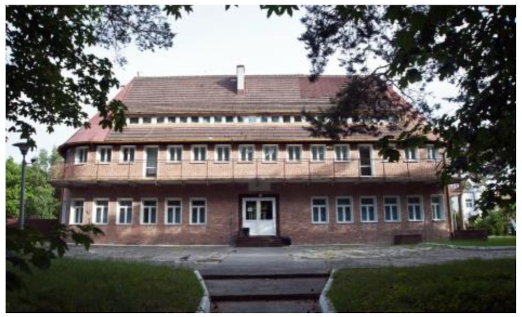 “Czarodziejka” holiday house. https://fotopolska.eu/ (accessed on 11 June 2021) Address: Chopina Street, no. 6 |
| 3 | “Celwiskoza” holiday house made up of camping houses
| No archival photos available Address: Wczasowa Street | |
| 4 | “Przystań” holiday house made up of 4 buildings:
| 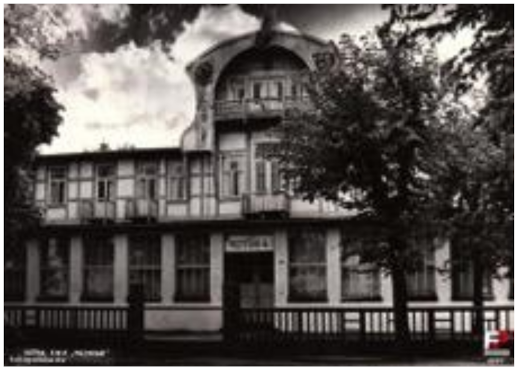 “Przystań” WHF in Ustka, between 1960 and 1970. https://fotopolska.eu/ (accessed on 3 May 2021) Address: Limanowskiego Street, no. 4 | |
| 5 | “Włókniarz” holiday house made up of 24 pavilions:
| 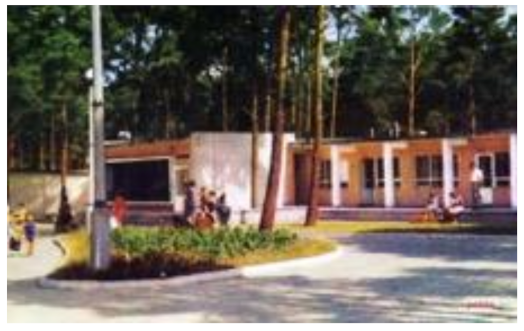 “Włókniarz” Holiday centre, 1968. Postcard by RUCH. https://fotopolska.eu/ (accessed on 3 May 2021) Address: Wczasowa Street | |
| Ustronie Morskie (26 buildings, 5 pavilions, 22 camping houses) | 1 | “Bałtyk” holiday house made up of 5 buildings:
| 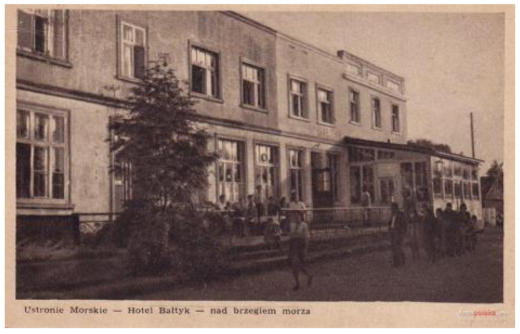 “Bałtyk” holiday house in Ustronie Morskie. https://fotopolska.eu/ (accessed on 3 May 2021) Address: Kościuszki Street, no. 6 |
| 2 | “Fala” holiday house made up of 7 buildings:
|  “Fala” holiday house in Ustronie Morskie, 1964-1966. Postcard RUCH. https://fotopolska.eu/ (accessed on 11 June 2021) Address: Bolesława Chrobrego Street, no. 76 | |
| 3 | “Lublinianka” holiday house made up of 4 buildings:
| 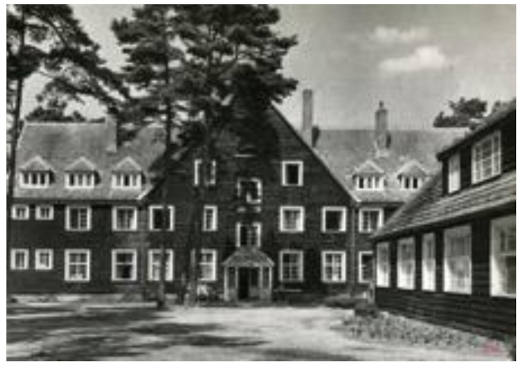 WHF’s Holiday House “Lublinianka 2”, between 1965 and 1967. Postcard by RUCH. https://fotopolska.eu/ (accessed on 12 June 2021) Address: Spokojna Street, no. 1 | |
| 4 | “Marysin” holiday house made up of 5 buildings:
| 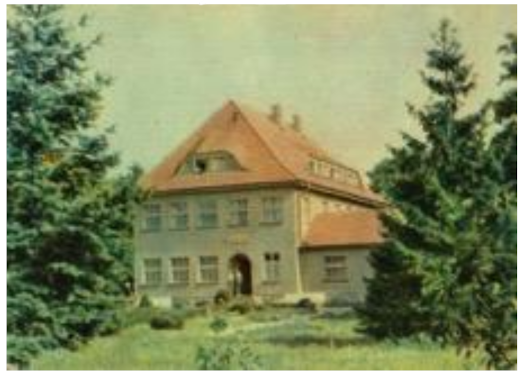 WHF’s “Marysin” House in Ustronie Morskie, between 1955 and 1962. Photo E. Czapliński and A. Stelmach. https://fotopolska.eu/ (accessed on 3 May 2021) Address: Bolesława Chrobrego Street, no. 84 | |
| 5 | “Pomorzanka” holiday house made up of 5 buildings:
|  Part of a housing estate, the Pomorzanka WHF’s holiday house is in the background, between 1967 and 1968. Photo A. Stelmach. Postcard by RUCH. https://fotopolska.eu/ (accessed on 3 May 2021) Address: Bolesława Chrobrego Street, no. 26 | |
Appendix C
Figure A1a–g, WHF’s holiday houses plans.

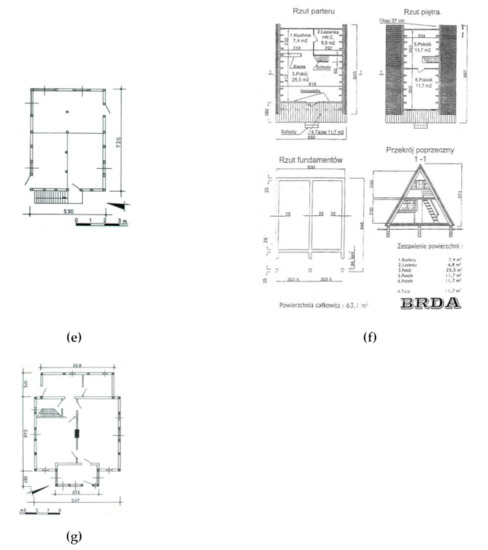
Figure A1.
Examples of WHF’s holiday houses plans: former villas and guesthouses in Międzyzdroje (a,b); large holiday facilities of the sanatorium type in Kołobrzeg (c,d), light temporary (seasonal) buildings in Międzyzdroje, Dziwnów and Międzywodzie (e–g).
References
- Aman, A. Architecture and Ideology in Eastern Europe during the Stalin Era. An Aspect of Cold War History; The MIT Press: New York, NY, USA, 1992. [Google Scholar]
- Ashworth, G.; Turnbridge, G.J. Dissonant Heritage: The Management of the Past as a Resource in Conflict; John Wiley and Sons: Chichester, UK, 1996. [Google Scholar]
- Eckhardt, P. Przestrzeń i architektura jako obraz doktryny politycznej. Przykład państw socjalistycznych (Space and architecture as an expression of political philosophy. The case of socialist countries). Miscell. Historico-Iuridica 2016, 15, 11–20. [Google Scholar] [CrossRef][Green Version]
- Górawski, B.; Wendt, J.A. Polityczne uwarunkowania kształtowania krajobrazu miasta (Political conditions of shaping the cityscape). J. Innovat. Natural Sci. 2019, 1, 29–35. [Google Scholar]
- Jałowiecki, B. Architektura jako ideologia (Architecture as ideology). Studia Region. Lokalne 2009, 3, 46–59. [Google Scholar]
- Yaneva, A. Five Ways to Make Architecture Political. An Introduction to the Politics of Design Practice; Bloomsbury Academic: London, UK, 2017. [Google Scholar]
- Minorski, J. O Polską Architekturę Socjalistyczną. Materiały z Krajowej Partyjnej Narady Architektów, Odbytej w Dniach 20–21.04.1949 roku w Warszawie (For Polish Socialist Architecture. Materials from the National Party Meeting of Architects Held on 20–21.04.1949 in Warsaw); Państwowe Wydawnictwa Techniczne: Warsaw, Poland, 1950. [Google Scholar]
- Kapa-Cichocka, M. MDM—KMA Warszawa—Warschau: Das Architektonische Erbe des Realsozialismus in Warschau. Architektoniczna Spuścizna Socrealizmu w Warszawie; Dom Spotkań z Historią: Warsaw, Poland, 2011. [Google Scholar]
- Gliński, A.; Kusztra, Z.; Müller, S. Architektura polska 1944–1984, Lata 1949–1956. Realizm socjalistyczny. Architektura 1984, 2, 65–80. [Google Scholar]
- Gliński, A.; Kusztra, Z.; Müller, S. Architektura polska 1944–1984, Lata 1956–1965. Poszukiwania. Architektura 1984, 3, 65–80. [Google Scholar]
- Jarosz, D. Masy Pracujące Przede Wszystkim. Organizacja Wypoczynku w Polsce 1945–1956 (Working Masses First. Organisation of Leisure in Poland 1945–1956); Akademia Świętokrzyska: Kielce, Poland, 2003. [Google Scholar]
- Pisarska, B. Rola wypoczynku socjalnego w Polsce podczas dekady 1970–1980 w świetle literatury [The role of social leisure in Poland during the 1970-1980 decade in the light of literature]. In Dekada Gierka, Wnioski dla Obecnego Okresu Modernizacji Polski; Rybiński, K., Ed.; Uczelnia Vistula: Warsaw, Poland, 2011; pp. 177–192. [Google Scholar]
- Pisarska, B. Zmiany statusu, zarządzania, infrastruktury i ruchu wczasowiczów FWP. In Od Autentyczności do Komercji—O Doświadczaniu w Turystyce, Warsztaty z Geografii Turyzmu; Tanaś, S., Mokras-Grabowska, J., Eds.; Wydawnictwo Uniwersytetu Łódzkiego: Łódź, Poland, 2014; Volume 4, pp. 107–120. [Google Scholar] [CrossRef]
- Jarosz, D. Państwowe organizowanie wypoczynku. Fundusz Wczasów Pracowniczych w latach 1945–1956. Polska 1944/45–1989. Studia Materiały 2001, 5, 49–108. Available online: https://rcin.org.pl/Content/59610/WA303_79134_B155-Polska-T-5-2001_Jarosz.pdf. (accessed on 20 February 2021).
- Niezabitowska, E. Metody i Techniki Badawcze w Architekturze (Research Methods and Techniques in Architecture); Wydawnictwo Politechniki Śląskiej: Gliwice, Poland, 2014. [Google Scholar]
- Groat, L.; Wang, D. Architectural Research Methods; John Willey & Sons, Inc.: Hoboken, NJ, USA, 2002. [Google Scholar]
- Worker holidays of WHF. In Informator FWP (Guidebook); Instytut Wydawniczy CRZZ: Warsaw, Poland, 1986.
- Constitution of the People’s Republic of Poland Enacted on July 22, 1952, Dz.U. 1952 nr 33 poz 232. Available online: http://libr.sejm.gov.pl/tek01/txt/kpol/1952a.html (accessed on 20 February 2021).
- Law of March 20, 1950, Amending the Law on Leave for Employees in Industry and Commerce. Dz.U. 1950 nr 13 poz. 123. Available online: http://isap.sejm.gov.pl/isap.nsf/download.xsp/WDU19500130123/O/D19500123.pdf (accessed on 20 February 2021).
- Law of April 29, 1969, on Workers’ Leave of Absence. Dz.U. 1969 nr 12 Poz. 85. Available online: http://isap.sejm.gov.pl/isap.nsf/download.xsp/WDU19690120085/O/D19690085.pdf (accessed on 20 February 2021).
- Bal, W.; Czałczyńska-Podolska, M. The stages of the cultural landscape transformation of seaside resorts in Poland against the background of the evolving nature of tourism. Land 2020, 9, 55. [Google Scholar] [CrossRef]
- Bal, W. Pluralistic trends in development of seaside landscape of Western Pomerania. Urban. Arch. Files 2018, 46, 483–495. Available online: http://yadda.icm.edu.pl/yadda/element/bwmeta1.element.baztech-beca1cc6-0422-4686-9d9d-a10ad350ebef/c/bal_pluralistyczne_30_2018.pdf (accessed on 20 February 2021).
- Worker holidays of WHF. In Informator FWP (Guidebook); Instytut Wydawniczy CRZZ: Warsaw, Poland, 1978.
- Kulczycki, Z. Zarys Historii Turystyki w Polsce (An Outline of the History of Tourism in Poland); Sport i Turystyka: Warsaw, Poland, 1970. [Google Scholar]
- Proniewicz, Z.; Soszyński, W. Dziesięć lat FWP: 1949–1958 w Liczbach i Wykresach (Ten Years of WHF: 1949–1958 in Numbers and Charts); FWP CRZZ: Warszawa, Poland, 1959. [Google Scholar]
- Statute of WHF of the Central Council of Trade Unions, M.P. 1950 Nr 3 Poz. 27. Available online: http://isap.sejm.gov.pl/isap.nsf/download.xsp/WMP19500030027/O/M19500027.pdf (accessed on 10 March 2021).
- Jakubowski, J. Akcja wczasόw na tle wspόłczesnej rzeczywistości polskiej (Vacation action against the background of contemporary Polish reality). Biuletyn Wczasόw 1947, 2. [Google Scholar]
- Central Council of Trade Unions (CRZZ) Department of the Presidency, 406. Resolution of the CRZZ Secretariat of January 13, 1950 on the tasks in the field of workers’ holidays. Archives of the Labour Movement.
- Ciarkowski, B. Recreational architecture at the service of politics—Dissonant heritage of holiday resorts from the era of the People’s Republic of Poland. J. Herit. Conserv. 2017, 49, 19–26. [Google Scholar] [CrossRef]
- Sierpiński, J. Wczasy Pracownicze w Polsce Ludowej (Workers’ Holidays in People’s Poland); CRZZ: Warsaw, Poland, 1968. [Google Scholar]
- Law of 4 February 1949 on the Employee Holiday Fund of the Central Commission of Trade Unions in Poland, Dz.U. 1949 nr 9 poz. 48. Available online: http://isap.sejm.gov.pl/isap.nsf/download.xsp/WDU19490090048/O/D19490048.pdf (accessed on 10 March 2021).
- Rogalewska, B. Tendencje Lokalizacyjne Zakładowych Ośrodków Wczasowych w Polsce do 1971 r. (Tendencies in the Location of Recreation Centres Controlled by the Establishments in Poland, until 1971); Instytut Geografii i Przestrzennego Zagospodarowania PAN: Warsaw, Poland, 1978. [Google Scholar]
- Sowiński, P. Wakacje w Polsce Ludowej. Polityka Władz i Ruch Turystyczny 1945–1989 (Vacations in People’s Poland. Government Policy and Tourism 1945–1989); Instytut Studiów Politycznych PAN Wydawnictwo TRIO: Warsaw, Poland, 2005. [Google Scholar]
- Cymer, A. Architektura w Polsce 1945–1989 (Architecture in Poland 1945–1989); Narodowy Instytut Architektury i Urbanistyki: Warszawa, Poland, 2018. [Google Scholar]
- Resolution No. 402 of the Council of Ministers of December 10, 1963, on Non-Operational Activities of a Social and Welfare Nature of State Enterprises M.P. 1963 Nr 95 Poz. 444. Available online: http://isap.sejm.gov.pl/isap.nsf/download.xsp/WMP19630950444/O/M19630444.pdf (accessed on 10 March 2021).
- Szczerski, A. Cztery Nowoczesności. Teksty o Sztuce i Architekturze Polskiej XX Wieku; Studio wydawnicze DodoEditor: Krakόw, Poland, 2015. [Google Scholar]
- Act of 21 April 1988 on the Workers’ Holiday Fund. Dz.U. 1988 nr 11 poz. 84. Available online: http://isap.sejm.gov.pl/isap.nsf/download.xsp/WDU19880110084/O/D19880084.pdf (accessed on 20 March 2021).
- Bal, W.; Dawidowski, R.; Raczyński, M.; Sietnicki, M.; Szymski, A. Architektura Polska lat 1961–1975 na Obszarze Pomorza Zachodniego (Polish Architecture of the Years 1961–1975 in the Area of Western Pomerania); Wyd. Walkowska: Szczecin, Poland, 2007. [Google Scholar]
- Thompson, J.B. Ideology and Modern Culture; Political Press: Cambridge, UK, 1990. [Google Scholar]
- Giddens, A. Sociology; Polity Press: Cambridge, UK, 2001. [Google Scholar]
- MacKenzie, I. The idea of ideology. In Political Ideologies: An Introduction; Eccleshal, R., Ed.; Routledge: London, UK, 2003; pp. 1–18. [Google Scholar]
- Hausladen, G. Planning the Development of the Socialist City: The Case of Dubna New Town. Geoforum 1987, 18, 103–115. [Google Scholar] [CrossRef]
- McKenzie, B. Marketing of the dark: “Memento Park” in Budapest. Emerald Emerg. Markets Case Stud. 2011, 1, 1–10. [Google Scholar] [CrossRef]
- Tandarić, N.; Watkins, C.; Ives, C.D. Urban planning in socialist Croatia. Croat. Geogr. Bull. 2020, 81, 5–41. [Google Scholar] [CrossRef]
- Gawroński, S.; Tworzydło, D.; Bajorek, K.; Łukasz, B. A Relic of Communism, an Architectural Nightmare or a Determinant of the City’s Brand? Media, Political and Architectural Dispute over the Monument to the Revolutionary Act in Rzeszów (Poland). Arts 2021, 10, 8. [Google Scholar] [CrossRef]
- Ismail, A.S. Architecture as an Expression of Political Ideology; Faculty of Built Environment Universiti Teknologi Malaysia: Johor, Malaysia, 2014. [Google Scholar]
- Ismail, A.S.; Zhaharin, E.N. Built Form Properties as Sign and Symbols of Patron Political Ideology. Jurnal Kejuruteraan 2017, 29, 87–96. [Google Scholar] [CrossRef]
- Jencks, C. The architectural sign. In Signs, Symbol and Architecture; Broadbent, G., Ed.; John Wiley and Sons: New York, NY, USA, 1980; pp. 71–118. [Google Scholar]
- Edelman, M. Space and The Social Order. Politics Design Symbol. 1978, 32, 2–7. [Google Scholar]
- Lefebvre, H. The Production of Space; Basil Blackwell Ltd.: Oxford, UK, 1991. [Google Scholar]
- Weber, R. On The Aesthetic of Architecture: A Psychological Approach to the Structure and Order of Perceived Architectural Space; Avebury: Aldershot, UK, 1995. [Google Scholar]
- Vale, J.L. Architecture, Power and National Identity; Yale University Press: London, UK, 1992. [Google Scholar]
- Thrift, N. Performing cultures in the new economy. In Cultural Economy: Cultural Analysis and Commercial Life; du Gay, P., Pryke, M., Eds.; SAGE Publications Ltd.: London, UK, 2002. [Google Scholar]
- Lefebvre, H. Prawo do miasta (The Right to the City). Praktyka Teoretyczna 2012, 5, 183–197. Available online: http://www.praktykateoretyczna.pl/PT_nr5_2012_Logika_sensu/14.Lefebvre.pdf (accessed on 1 November 2021). [CrossRef]
- Jałowiecki, B. Społeczne Wytwarzanie Przestrzeni (Revised Edition) (The Social Production of Space (Revised Edition)); Wydawnictwo Naukowe Scholar: Warsaw, Poland, 2010. [Google Scholar]
- Majmurek, J. Architektura PRL: Nie Tylko Polityka. 2018. Available online: https://krytykapolityczna.pl/kultura/czytaj-dalej/architektura-prl-rozmowa-z-anna-cymer-majmurek/ (accessed on 10 May 2021).
- Springer, F. Źle Urodzone (Wrongly Born); Karakter: Warsaw, Poland, 2011. [Google Scholar]
- Libicki, B. Turystyka socjalna w Polsce [social tourism in Poland]. In 30 Lat Działalności Funduszu Wczasów Pracowniczych 1949–1979. Osiągnięcia i Perspektywy; Materiały z sympozjum naukowego, Spała 22–24 II 1979; Instytut Wydawniczy CRZZ: Warsaw, Poland, 1980. [Google Scholar]
- Węcławowicz-Bilska, E. Kształt przestrzeni zdrojowiska [The shape of the spa space]. In Architektura Kurortowa; Materiały z ogólnopolskiej konferencji „Architektura kurortowa”, Połczyn Zdrój, 24-25 kwietnia 2009; Szczecin EXPO: Szczecin, Poland, 2009; pp. 29–40. [Google Scholar]
- Węcławowicz-Bilska, E. Polskie uzdrowiska u progu XXI wieku (Polish spas at the turn of the 21st century). In Projektowanie Architektury na Terenach o Szczególnych Walorach Krajobrazowych i Uzdrowiskowych; Bocheński, S., Ed.; Oficyna Wydawnicza Politechniki Wrocławskiej: Wrocław, Poland, 2012; pp. 29–42. [Google Scholar]
- Bal, W.; Czałczyńska-Podolska, M. Assessing Architecture-and-Landscape Integration as a Basis for Evaluating the Impact of Construction Projects on the Cultural Landscape of Tourist Seaside Resorts. Land 2021, 10, 17. [Google Scholar] [CrossRef]
- Yari, F.; Mansouri, S.; Žurić, J. Political architecture and relation between architecture and power. Int. J. Latest Res. Human. Soc. Sci. 2012, 1, 84–90. [Google Scholar]
Publisher’s Note: MDPI stays neutral with regard to jurisdictional claims in published maps and institutional affiliations. |
© 2021 by the authors. Licensee MDPI, Basel, Switzerland. This article is an open access article distributed under the terms and conditions of the Creative Commons Attribution (CC BY) license (https://creativecommons.org/licenses/by/4.0/).